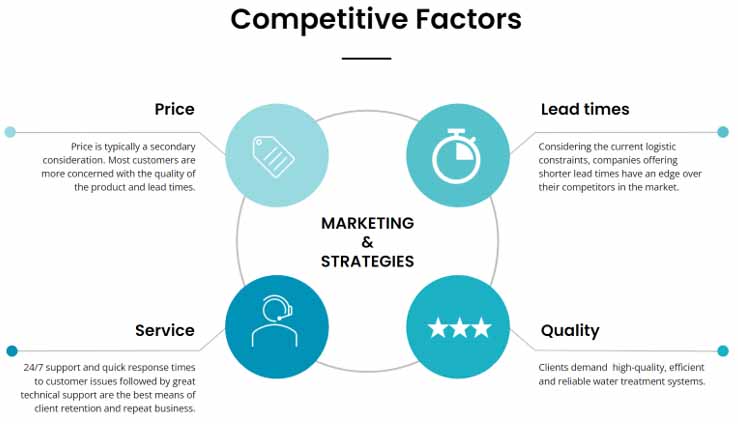U.S. Commercial Water Treatment Market Trends
By Shilpa Tiku

The United States commercial water treatment market was valued at over $5.0 billion in 2021 and is expected to witness a compound annual growth rate (CAGR) of between 5.0 to 10.0 percent over the next 7 years. Key players in this market include Culligan International Co., Ecolab, Inc., Evoqua Water Technologies Corp., and Pentair Industries, Inc.
The U.S. commercial water treatment market is highly competitive. There are several regional players in market that have a very large local presence with little to no national breadth. Market participants include both OEMs and system integrators. During Verify Markets’ interviews with key players, manufacturers stated that end-user requirements are not readily visible due to the localized nature of the marketplace and differences in end-user requirements around the country. The market is fairly saturated, and it is likely that mergers and acquisitions will continue throughout the forecast period. Overall, the commercial water treatment market is expected be a solid market throughout the forecast period (2022-2029).
End user trends
The food service industry is the main end user group for commercial water treatment applications, making up an estimated 18.0 percent of the end user market by revenue in 2021. The food service industry is dependent on water treatment systems to provide high quality drinking water to its customers, as well as extend the life of the appliances that water comes in contact with and reduce the use of chemicals and detergents.
The quality of water that is being utilized by carwashes has a significant impact on the longevity of the washing equipment, as well as the efficiency of soaps, detergents, and chemicals. Stringent environmental regulations are requiring car washes to employ a system to recycle water for reuse.
The use of water softeners at commercial buildings is increasingly growing. Commercial end users that require high-purity water, such as hospitals, colleges, and labs, have been increasing over the last five years.
Other end users that use commercial water treatment systems include the agricultural and wine industries, among others.
Point-of-entry (POE) systems
POE systems dominate the United States Commercial Water Treatment market. These systems are considered more efficient as compared to point-of-use (POU) systems. Nevertheless, installation and maintenance costs associated with these systems are high, leading small commercial customers to opt for a POU system.
Market drivers
Key market drivers for the U.S. commercial water treatment market include sustainability trends, water reuse in commercial real estate, emerging contaminants, aging water infrastructure, and an increase in non-residential construction spending.
Sustainability trend
As consumers are becoming more interested in making sustainability-focused choices, companies are increasingly looking for water treatment solutions that allow them to do more with the same amount of, or even less, water. Water sustainability in the hospitality industry is also becoming a major trend as hotels typically have a larger environmental impact than similarly sized non-hotel buildings. One initiative includes water recycling within the hotel premises.
Market restraints
Key market restraints include a highly competitive market, a lower demand from the hospitality segment, shortage of skilled personnel, and supply chain constraints.
Shortage of skilled personnel
Commercial water treatment equipment requires trained personnel for planning, design, installation, and services. U.S water treatment companies are having difficulty finding and retaining skilled talent. This shortage can often result in poor system designs and installation, in addition to difficulty in troubleshooting problems during maintenance and repairs. Moreover, a scarcity of qualified personnel is limiting the growth potential of some companies.
Supply chain constraints and COVID-19
The COVID-19 pandemic has affected the production of water treatment system components and raw materials due to the temporary closure of many factories and supply chain delays within affected countries, especially in Asia. Port congestion, difficulty in getting truck drivers, and rising costs for raw materials and components are also important factors contributing to supply chain constraints. Lead times have increased exponentially, and delays expected to continue for the near-term. Sudden increases in demand from the commercial sector, especially from food service facilities, has exacerbated these constraints. Some companies have been able to maintain business continuity by utilizing safety stock inventory levels and executing novel air freight strategies.
The chart below illustrates the competitive factors in this market.

To read the Verify Markets U.S. commercial water treatment equipment market report or request an executive summary, contact Verify Markets at info@verifymarkets.com or call +1.210.595.9687.
Shilpa Tiku is the Chief Research Officer at Verify Markets. Shilpa has experience in research and consulting for over 19 years. She focuses on monitoring and analyzing emerging trends, technologies and market dynamics in several global markets. To reach her for comments, interviews, or market consulting, call +1 210.595.9687 or email her at shilpa.tiku@verifymarkets.com.
About Verify Markets
The Verify Markets team is a group of market experts, creative thinkers, business analysts, and independent consultants located around the world. We work with our clients to bring solutions to every project and deliver reliable data and trends based on primary research. Our Research & Consulting practice provides global industry analysis, custom engagements, end-user analysis, strategy consulting, strategic market intelligence, and forecasts that are designed to facilitate strategic decision-making. Our team continuously monitors and evaluates information to create insights for your business needs.
A commercial water treatment system refers to the entire commercial system installed at the end- user site that includes membranes, housing, pumps, filters, valves, fittings, tubing, framing, etc. Manufacturers that operate in the systems category sometimes produce components and often label, integrate, and assemble components provided by other manufacturers. Modules refer to a component of the overall system used to treat the water. Point-of-entry (POE) systems refer to installed systems that treat water while entering the facility. Point-of-use (POU) systems refer to a self-contained unit that is used to treat water at the point of consumption.
